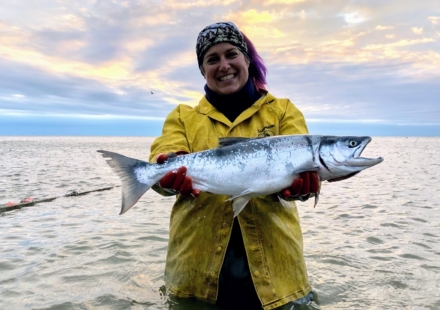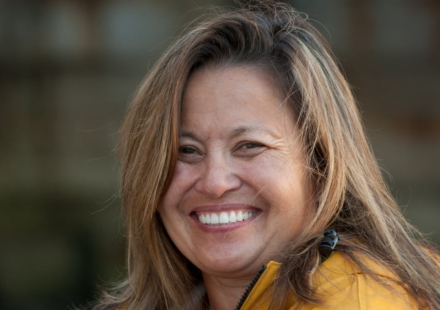
[Fishing] challenges me daily, making me feel very alive—and mortal. I am humbled constantly by some element of fishing in a way that doesn’t happen in my land-lubber life. It’s simultaneously exhausting and invigorating, and I am constantly reminded of my limitations.
What do you love most about fishing?
I love that my job is on the water and not confined to four walls. I’ve had indoor jobs, and I like how they work a different part of my mind, but there is something beautiful about the variety and movement and changeability of fishing.
What are your favorite memories from fishing?
Many of my favorite fishing memories involve my children on my ex-husband’s seine boat the Sound Quest during the ’90s. We had kids stashed everywhere—even under the steering consul, where we had to make a custom cover to protect the switches! Among the many memorable seining days, I remember naked kids in the crows nest, iceberg swimming, bonfire roasted oysters, mining for crystals, glass ball hunting, and bays scented in cedar.
What does sustainability mean to you?
A sustainable fishery is one in which all user groups and the myriad elements in the salmon’s ecosystem are addressed and healthy. From one year to the next, we never know if there is a future in this fishery, what with changing politics and environmental factors, so striving for sustainability is the only path.


What’s your family’s history in the seafood industry?
My family had no connection to the seafood industry, even though we lived in Soldotna between the Kasilof and Kenai Rivers. Shockingly, no seafood at all was cooked in my house–my parents were very un-Alaskan! It wasn’t until I was 17 and a friend took me on my first boat ride on the Kenai and then another friend took me dipnetting on the Kasilof that I was first exposed to fishing for and eating salmon—and I’ve never looked back. I could eat salmon every day and never tire of it!
What do you want consumers to know about fishing in Alaska?
Salmon are a delicious, versatile, and healthy food source. I’d like consumers to know that I care about the product. I am religious about gilling and slush icing in small fish bags (so as not to crush the fish), and my fish holds are insulated. I pick my net while fish are still alive, for optimal bleeding. Many boats now have bleed tanks, which further improves the quality. I deliver often to the tenders to the benefit of the consumer, as well as to get fresh ice and keep my boat light for quick, economic travel. My fish bags, slush bags, fish hold and deck are cleaned frequently. I take pride in the fish I deliver because I want the end user to enjoy this amazing, sustainable food source.
Strong at Sea
The “Strong At Sea” collection celebrates the women fishing Alaska’s waters for wild, natural and sustainable seafood. Captured on deck during the summer of 2019 in the Copper River and Prince William Sound fishing areas, these female fishermen represent the heart and soul of Alaska’s commercial fleet.




